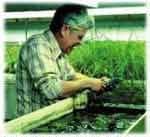The Beginning

The story of one of the world’s foremost freshwater research institutions began in the salt waters of the Pacific Ocean.
In 1956 W.B. Dixon Stroud joined a snail-collecting expedition from the Academy of Natural Sciences and spent two months off the coast of New Guinea diving for live shells.
This was not Dick Stroud’s first immersion in Pacific waters.
Eleven years earlier he had been officer of the deck when the USS William D. Porter was hit by a kamikaze pilot during the Battle of Okinawa. The ship sank in 90 minutes. None of the crew was killed in the attack, but, as second in command, Lieutenant Stroud was the next-to-last man off. His subsequent Pacific voyage left a better memory.
It also introduced Dick Stroud to the scientific research efforts of the Academy.
That introduction bore fruit nine years later when he and his wife, Joan, met Ruth Patrick, Ph.D., the head of the Academy’s limnology department. The three quickly became friends, and Patrick urged the Strouds to build a small laboratory dedicated to freshwater research along White Clay Creek on their farm in southern Chester County.

They made a special team. Ruth was a relentless worker and one of the country’s foremost scientists. Dick had a head for business, a fascination with science and a love of the outdoors.
Joan brought a deep commitment to education, a drive to get things done and an unquenchable curiosity.
“I remember an early trip to a forestry conference at Oregon State,” said Robin Vannote, the Center’s first director. “Joan was studying every inch of the way.”
Perhaps above all, she had an unsurpassed ability to turn an empty building into an inviting and inspiring place.
In the summer of 1966, Stroud Water Research Center began its existence as a field station of the Academy in a hastily cleared space above the Stroud’s garage.


Hot, dusty and dark, the attic made the cool streams, where the real scientific work was to be done, look inviting indeed.
Patrick’s first act was to hire Vannote, a young scientist working for the Tennessee Valley Authority. By early fall his experimental leaf packs had become a familiar sight in the local streams.
In a letter dated June 30, 1966, Academy President John Bodine outlined the first year’s budget to Dick Stroud. Because the $46,100 total included $15,000 for equipment, Bodine estimated a figure of $36,250 for subsequent years. It was up to the Strouds and the Stroud Center staff to come up with the money.

The forecast was on target. The Stroud Center’s expenditures for its first fiscal year were $46,126.29. It is one measure of how much has happened in the intervening years that the Stroud Center now has a multi-million dollar budget.
But while the Stroud Center has grown, its essence has not changed. “Ruth and Robin set the tone,” said Bern Sweeney, the current director. “They were constantly challenging, asking hard questions, never satisfied, always demanding another experiment. It’s the same now. It’s an intense and focused place.”
The scientists continue to ask fundamental questions. They work as a team, and their sights are still set on the long term. In a world where clean water is no longer taken for granted, they remain determined to make a difference.
Learn More About Our History
The Beginning | The Watershed | Landmark Research | Art and Science | Road to Independence | Building Blocks
Celebrate Stroud Water Research Center’s history — from its humble beginning in Joan and Dick Stroud’s garage to a world-renowned freshwater research institution — with our anniversary book, The First Fifty Years.
